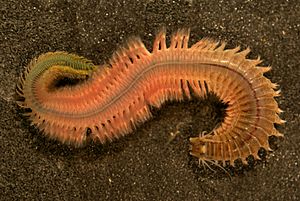Common clam worm facts for kids
Quick facts for kids Clam worm |
|
|---|---|
 |
|
| Scientific classification | |
| Kingdom: | |
| Phylum: | |
| Class: | |
| Order: |
Phyllodocida
|
| Family: |
Nereididae
|
| Genus: |
Nereis
|
| Species: |
N. succinea
|
| Binomial name | |
| Nereis succinea (Frey & Leuchart, 1847)
|
|
The Common clam worm (Nereis succinea) is a type of polychaete worm that lives in many parts of the world. Polychaetes are a group of worms that live in the sea. People sometimes call this worm a ragworm or sandworm. But these names can also be used for other similar worms. The name "common clam worm" helps us know which worm we are talking about. This worm looks a bit like a millipede.
Contents
What Does the Clam Worm Look Like?
The common clam worm can grow up to 15 centimeters (about 6 inches) long. But most of them are smaller. The back part of its body is brown. The rest of its body is a reddish-brown color.
Its head has four eyes. It also has two special feelers called palps. These palps help the worm sense things around it. It also has eight tentacles, which are like small arms.
Where Do Clam Worms Live and What Do They Eat?
The common clam worm lives in shallow ocean waters. It swims freely near the bottom. It is a scavenger, which means it eats dead plants and animals. It also eats other small worms and algae. Algae are like tiny plants that grow in water.
To catch its food, the clam worm uses a special part called a proboscis. This proboscis is like a tube that can shoot out. It has two hooks at the end. The worm uses these hooks to grab its food and pull it into its mouth.
Clam worms are an important food source for fish that live on the ocean floor. They are also eaten by crustaceans, like crabs and shrimp. To protect itself, the clam worm can make a slimy substance. This slime hardens and forms a protective cover around the worm.
How Do Clam Worms Reproduce?
In the spring and early summer, during certain moon phases, clam worms go through a big change. This change is called "heterogenesis." During this time, their parapodia get much bigger. Parapodia are small, leg-like parts on the worm's body. When they get bigger, they help the worm swim better.
After this change, the clam worms are ready to reproduce. They release their eggs and sperm into the water. Once they have released their eggs or sperm, the adult worms die.
Tiny planktonic larvae then develop from the eggs. Planktonic means they float in the water. These larvae are very small. They grow into young worms, which are a type of annelid (segmented worm). Eventually, these young worms sink to the bottom of the ocean. There, they continue to grow into adult clam worms.
Images for kids
See also
 In Spanish: Alitta succinea para niños
In Spanish: Alitta succinea para niños


